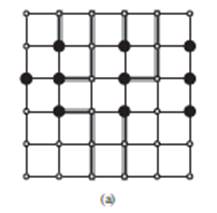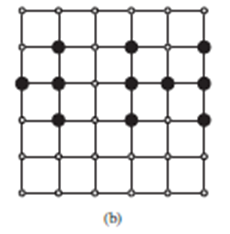
(a)
To explain the determining of the maximum flow in a network with edge and vertex capacities can be reduced to an ordinary maximum-flow problem on a flow network of comparable size.
(a)
Explanation of Solution
Given Information:The network is given below:

Explanation:
The constraints can be covered by splitting the vertex into two then the edge in between two vertices of the network will be the vertex capacity for the graph.
The maximum flow of the network is determined by consider the path so that the graph has maximum capacity.
The steps to determine the maximum-flow is given below:
Step 1: Split the vertex into 2 and formed new network of vertices u and v.
Step 2: The splitting results the new vertices of new network is
Step 3: Check the graph for edge
Step 4: The new network consists of edge as
Step 5: To obtain the maximum flow consider the v as it goes from
Thus, in this way the new flow network is formed having maximum flow.
(b)
To describes an efficient
(b)
Explanation of Solution
Given Information:The figure with no escape grid is given below:

Explanation:
The escape problem can be solved as follows:
Step 1: Built a flow network with unit capacity by considering vertex constraints.
Step 2: Consider the above figure select the unit edge that intersecting the grid lines of adjacent grid.
Step 3: The available network has bidirectional edges with unit capacity so put a unit capacity corresponding to edges going to source s to other vertices.
Step 4: The capacity of the edges is unity so all the augmented paths will be unity.
Step 5: The augmented path defines the path to escape that is escape path is equal to m , where m is vertex disjoint path.
Step 6: Checks the value of maximum flow if it is less than the m then it is not the required escape path.
The path obtained from the above algorithm can be crossed verified by the vertex disjoint path it satisfy the equality then it is required escape path otherwise the flow network cannot have any escape path.
Want to see more full solutions like this?
Chapter 26 Solutions
Introduction to Algorithms
- 5. Given an undirected graph with n vertices and m edges, find an O(n+m) time algorithm that determines whether it is possible to color all the vertices red and blue such that every edge is between a red vertex and blue vertex. If such a coloring exists, your algorithm should produce one.arrow_forwardIn the figure below there is a weighted graph, dots represent vertices, links represent edges, and numbers represent edge weights. S 2 1 2 1 2 3 T 1 1 2 4 (a) Find the shortest path from vertex S to vertex T, i.e., the path of minimum weight between S and T. (b) Find the minimum subgraph (set of edges) that connects all vertices in the graph and has the smallest total weight (sum of edge weights). 2. 3.arrow_forwarda 2. Consider the graph G drawn below. d b e a) Give the vertex set of the G. Give the set of edge of G. b) c) Find the degree of each of the vertices of the graph G. d) Add the degrees of all the vertices of the graph G and compare that sum to the number of edges in G, what do you find? e) Give a path of length 1, of length 2, and of length 3 in G. f) Find the longest path you can in G? h (Remember that you cannot repeat vertices).arrow_forward
- Let u and v be a pair of vertices in the graph of K6.Then the number of circuits of length 4 that pass through u and v is Select one : a). 4 b) 8 c) 6 d) 5 e). Nonearrow_forward5. (This question goes slightly beyond what was covered in the lectures, but you can solve it by combining algorithms that we have described.) A directed graph is said to be strongly connected if every vertex is reachable from every other vertex; i.e., for every pair of vertices u, v, there is a directed path from u to v and a directed path from v to u. A strong component of a graph is then a maximal subgraph that is strongly connected. That is all vertices in a strong component can reach each other, and any other vertex in the directed graph either cannot reach the strong component or cannot be reached from the component. (Note that we are considering directed graphs, so for a pair of vertices u and v there could be a path from u to v, but no path path from v back to u; in that case, u and v are not in the same strong component, even though they are connected by a path in one direction.) Given a vertex v in a directed graph D, design an algorithm for com- puting the strong connected…arrow_forwardGiven the following Graphs: Graph A: В 12c 1 4. E F G- H 4 J K 3 Graph B: Graph B is the undirected version of Graph A. 3.arrow_forward
- 36. Let G be a simple graph on n vertices and has k components. Then the number m of edges of G satisfies n-k ≤m if G is a null graph. This statement is A. sometimes true B. always true C. never true D. Neither true nor falsearrow_forwardOne can manually count path lengths in a graph using adjacency matrices. Using the simple example below, produces the following adjacency matrix: A B A 1 1 B 1 0 This matrix means that given two vertices A and B in the graph above, there is a connection from A back to itself, and a two-way connection from A to B. To count the number of paths of length one, or direct connections in the graph, all one must do is count the number of 1s in the graph, three in this case, represented in letter notation as AA, AB, and BA. AA means that the connection starts and ends at A, AB means it starts at A and ends at B, and so on. However, counting the number of two-hop paths is a little more involved. The possibilities are AAA, ABA, and BAB, AAB, and BAA, making a total of five 2-hop paths. The 3-hop paths starting from A would be AAAA, AAAB, AABA, ABAA, and ABAB. Starting from B, the 3-hop paths are BAAA, BAAB, and BABA. Altogether, that would be eight 3-hop paths within this graph. Write a program…arrow_forwardIn graph theory, graph coloring is a special case of graph labeling; it is an assignment of labels traditionally called "colors" to elements of a graph subject to certain constraints. In its simplest form, it is a way of coloring the vertices of a graph such that no two adjacent vertices share the same color; this is called a vertex coloring. The chromatic number of a graph is the least mumber of colors required to do a coloring of a graph. Example Here in this graph the chromatic number is 3 since we used 3 colors The degree of a vertex v in a graph (without loops) is the number of edges at v. If there are loops at v each loop contributes 2 to the valence of v. A graph is connected if for any pair of vertices u and v one can get from u to v by moving along the edges of the graph. Such routes that move along edges are known by different names: edge progressions, paths, simple paths, walks, trails, circuits, cycles, etc. a. Write down the degree of the 16 vertices in the graph below: 14…arrow_forward
- 2. [20 points][MID] The graph k-coloring problem is stated as follows: Given an undirected graph G = (V, E) with N vertices and M edges and an integer k. Assign to each vertex v in V a color e(r) such that 1 < e{u) < k and c(u) # c(v) for every edge (u, v) in E. In other words you want to color each vertex with one of the k colors you have and no two adjacent vertices can have the same color. For example, the following graph can be 3-colored using the following color assignments: a=1,b=2,c=1,d%32,e=3,f=2.g33 a---b---c---g d Formulate the graph k-coloring problem as an evolutionary optimization. You may use a vector of integer representation, OR any representation that you think is more appropriate. you should specify: • A representation. • itness function. Give 3 examples of individuals and their fitness values if you are solving the above example. A set of mutation and/or crossover and/or repair operators. Intelligent operators that are suitable for this particular domain will earn…arrow_forward5. Fleury's algorithm is an optimisation solution for finding a Euler Circuit of Euler Path in a graph, if they exist. Describe how this algorithm will always find a path or circuit if it exists. Describe how you calculate if the graph is connected at each edge removal. Fleury's Algorithm: The algorithm starts at a vertex of v odd degree, or, if the graph has none, it starts with an arbitrarily chosen vertex. At each step it chooses the next edge in the path to be one whose deletion would not disconnect the graph, unless there is no such edge, in which case it picks the remaining edge (a bridge) left at the current vertex. It then moves to the other endpoint of that edge and adds the edge to the path or circuit. At the end of the algorithm there are no edges left ( or all your bridges are burnt). (NOTE: Please elaborate on the answer and explain. Please do not copy-paste the answer from the internet or from Chegg.)arrow_forward3. Kleinberg, Jon. Algorithm Design (p. 519, q. 28) Consider this version of the Independent Set Problem. You are given an undirected graph G and an integer k. We will call a set of nodes I "strongly independent" if, for any two nodes v, u € I, the edge (v, u) is not present in G, and neither is there a path of two edges from u to v. That is, there is no node w such that both (v, w) and (u, w) are present. The Strongly Independent Set problem is to decide whether G has a strongly independent set of size at least k. Show that the Strongly Independent Set Problem is NP-Complete.arrow_forward
 Database System ConceptsComputer ScienceISBN:9780078022159Author:Abraham Silberschatz Professor, Henry F. Korth, S. SudarshanPublisher:McGraw-Hill Education
Database System ConceptsComputer ScienceISBN:9780078022159Author:Abraham Silberschatz Professor, Henry F. Korth, S. SudarshanPublisher:McGraw-Hill Education Starting Out with Python (4th Edition)Computer ScienceISBN:9780134444321Author:Tony GaddisPublisher:PEARSON
Starting Out with Python (4th Edition)Computer ScienceISBN:9780134444321Author:Tony GaddisPublisher:PEARSON Digital Fundamentals (11th Edition)Computer ScienceISBN:9780132737968Author:Thomas L. FloydPublisher:PEARSON
Digital Fundamentals (11th Edition)Computer ScienceISBN:9780132737968Author:Thomas L. FloydPublisher:PEARSON C How to Program (8th Edition)Computer ScienceISBN:9780133976892Author:Paul J. Deitel, Harvey DeitelPublisher:PEARSON
C How to Program (8th Edition)Computer ScienceISBN:9780133976892Author:Paul J. Deitel, Harvey DeitelPublisher:PEARSON Database Systems: Design, Implementation, & Manag...Computer ScienceISBN:9781337627900Author:Carlos Coronel, Steven MorrisPublisher:Cengage Learning
Database Systems: Design, Implementation, & Manag...Computer ScienceISBN:9781337627900Author:Carlos Coronel, Steven MorrisPublisher:Cengage Learning Programmable Logic ControllersComputer ScienceISBN:9780073373843Author:Frank D. PetruzellaPublisher:McGraw-Hill Education
Programmable Logic ControllersComputer ScienceISBN:9780073373843Author:Frank D. PetruzellaPublisher:McGraw-Hill Education





